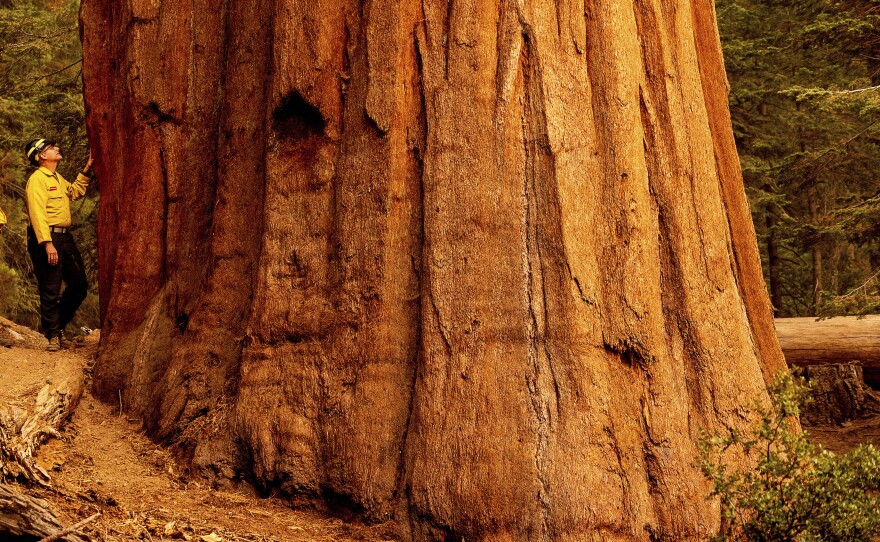Speaker 1: (00:00)
A half dozen or so wildfires still burning in Northern California are all now at least 75% contained, but through the summer mega fires like the Dixie and Kaldor blazes, threatened homes and communities, and even a part of California's heritage, the giant sequoias, which can live for thousands of years, at least 30 of the giant trees and Sequoia national forest were destroyed by fire last month. That's on top of the 10 to 15% of all the state's sequoias that were destroyed by fire. Last year, since wildfire in California is expected to become more frequent and intense experts are struggling to find ways to protect California's great ancient forests and journey me is Kurt peacock. He is an ISA certified arborist with tree San Diego and Kurt. Welcome to the program.
Speaker 2: (00:52)
Thank you for having me
Speaker 1: (00:54)
Tell us about the sequoias. Are they only found here in California? Yes.
Speaker 2: (00:59)
Giant sequoias that we refer to are found only here in California and the giant Sequoia is a separate species from the coast redwoods.
Speaker 1: (01:09)
And how long do the giant sequoias live? How big do they grow
Speaker 2: (01:13)
With the largest living thing on earth is the general sermon giant Sequoia in Kings canyon, national park. And they can grow to be well over 200 approaching 300 feet tall and live somewhere between two and as many as four or 5,000 years.
Speaker 1: (01:30)
Do we have many ancient, giant Sequoia groves in California? How many are there?
Speaker 2: (01:37)
We really don't. There are extensive logging in the late 19th century and early 20th century reduced some of the biggest giants and they were taken down before preservation could occur. And that is why the national park service protected them because there were so few after logging was done too much at the big old growth stands.
Speaker 1: (01:59)
And what about in Southern California? Do the giant sequoias only grow in the north?
Speaker 2: (02:04)
Yes. They have a very limited range, at least currently to the higher elevations of the Sierra attempting to grow them here in Southern California just leads to very unhappy trees because we tend to have, you know, not enough moisture and not enough humidity for their liking.
Speaker 1: (02:20)
Now these huge wildfires in Northern California this year and last year have raised the alarm about the survival of these trees. How severely do you think they're threatened?
Speaker 2: (02:32)
I would rate it as moderate to severe given the current conditions and the intensity of these recent wildfires.
Speaker 1: (02:40)
Now, recently we heard about a technique of wrapping the bottoms of the trees with foil to try to protect them. Here's Stan hill, he's a us forest service, deputy forest management officer.
Speaker 3: (02:52)
The idea behind the foil is to protect structures and sometimes trees, other things in places that we, where a fire is going to impact.
Speaker 1: (03:04)
Now, have we seen this method work to save these big trees
Speaker 2: (03:08)
In the case of the general Sherman, that was the tree that was wrapped and it was successful at preventing, uh, lower ignition and climbing the ladder as we call it in fire into the canopy of the tree. So it was a very iconic tree and a very special tree. And, uh, the material seemed to protect it. Although they did lose in this last fire, they did lose one of the larger ones in the Grove, not nearly the general sermon size, but they were able to, you know, the forest service and all Cal fire and all they do are able to save the majority of those trees.
Speaker 1: (03:44)
Now wrapping the foil around the bottom. I I'm confused because don't trees usually catch fire from the top.
Speaker 2: (03:50)
The thing is what happens and classic fire scenario is that they have what they call a fuel ladder in most forest rebuilds up on the forest floor that then ignites and then climbs a ladder into the canopies of the trees. And one of the saving graces for the sequoias is that many of them don't begin branching until 60 or more than a hundred feet into the air. So the fuel ladder is a huge leap from the forest floor debris to get to that upper canopy with younger trees and other Pines. That's not the case. And that's why those forests burn much more readily when they ignited.
Speaker 1: (04:29)
Is this foil or some similar structure on the bottom around these trees? Is that a practical idea to try to save the giant Sequoia
Speaker 2: (04:38)
In large scale? I don't think so because of the cost. I mean, it was a great thing to do to that special iconic tree, the largest living thing on earth. Uh, and I think that was definitely warranted, but more has to be done for, you know, fuel management to prevent the fires from reaching the intensity that they have recently.
Speaker 1: (05:00)
Now, other than wildfires, what other environmental challenges are facing these giant sequoias,
Speaker 2: (05:06)
Our changing climate and the intensity of storms. And then of course, especially the lack of snow pack in the Sierras, which is what they count on. And you realize over the last few years, we've had very up and down winters. Um, snowpack 70% below normal, I believe one of the last two years, and that can be devastating for them because without enough moisture and without enough cold, they don't function as properly. And then they sometimes will become like the Pines susceptible to boring beetles.
Speaker 1: (05:40)
And why is saving the giants? Coya so important
Speaker 2: (05:43)
Because there's such a limited range is that they're iconic. There is no other tree that comes close to mass and size. And we know from historic fossil records, even that the Sequoyah giant sequoias used to occupy a huge, huge section of north America historically. And over the hundreds of thousands of years, that range has shrunk down to that last population at the top of the Sierras and man-made impact and what we do and climate change has caused them. Their population did dwindle, but the extinction of any species on this planet is a tragedy, especially something as massive and majestic as those giant sequoias.
Speaker 1: (06:26)
I've been speaking with Kurt peacock. He is an ISA certified arborist with tree San Diego. Kurt. Thank you so much.
Speaker 2: (06:34)
You're very welcome.







